Restoration continues at Copper Harbor Lighthouse in Keweenaw County
By BARRY C. JAMES
Michigan Department of Natural Resources
Standing as a silent guard at the very top of the Upper Peninsula, the Copper Harbor Lighthouse once guided vessels traveling in Lake Superior to safe harbor.
Originally built in 1848, the lighthouse site consisted of a 44-foot stone tower with a lantern room, a detached lightkeeper’s dwelling and landing dock.
By the 1860s, the Keweenaw Peninsula’s harsh winters and Lake Superior’s severe weather had taken their toll on the original buildings. The U.S. Lighthouse Service replaced the stone structures with a brick lighthouse and attached living quarters.
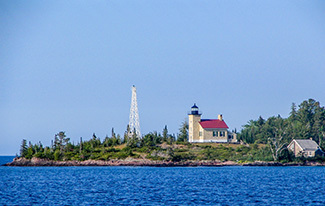
Beginning in 1866, the new lighthouse was manned by lightkeepers and their families until it was automated in 1919. By 1958, the lighthouse had become obsolete, and the U.S Coast Guard sold the property to the Michigan Department of Natural Resources.
Today the lighthouse site, which is part of Fort Wilkins Historic State Park, includes the original 1848 keeper’s quarters and the 1866 lighthouse. While time may have changed the lighthouse’s purpose, the need to protect the historic buildings from the elements is still pressing.
Michigan’s historic state parks offer visitors the unique experience to view, enjoy and learn about site histories and their significant structures. As stewards of these places, the DNR is responsible not only for telling their stories, but also for their preservation and maintenance.
This can be a challenging task when working on buildings that are almost 200 years old, as was the case at the Copper Harbor Lighthouse in the summer of 2019. The lighthouse is comanaged by the DNR’s Michigan History Center and Parks and Recreation Division.
“For several years we had been monitoring brick and mortar issues within the fort and a brick spalling issue at the Copper Harbor Lighthouse,” said Fort Wilkins Historic State Park manager Bob Wild.
|
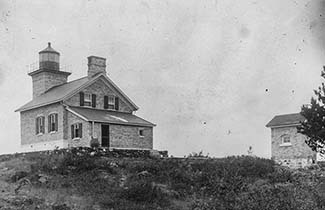
Brick spalling is when the surface of a brick flakes off.
“In addition to the lighthouse, the 1848 lighthouse keeper’s dwelling had some structural issues. It is the original keeper’s dwelling – arguably the oldest lighthouse related structure on Lake Superior,” Wild said.
Some of the maintenance and preservation issues are a result of past missteps in caring for the building. In order to remove decades of paint from the 1866 lighthouse’s surface in the late 1960s, park staff sand-blasted the lighthouse’s exterior.
Unfortunately, the work also removed the original brick finish, which eventually allowed water to leach into the brickwork. Over time, the natural freezing and thawing cycle caused pieces of brick to break, or “pop,” off the building.
Fixing this problem was not simple. The Copper Harbor Lighthouse is listed on the National Register of Historic Places, and historic buildings require extra care and attention.
|
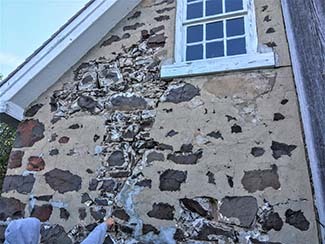
In accordance with Michigan’s State Historic Preservation Office, all materials must meet the Secretary of the Interior's Standards for the Treatment of Historic Properties. With buildings, this includes working with original materials, including brick, mortar and paint colors.
Due to the scope of the project, which included repairs to the old keeper’s house foundation and walls, it was decided to bid out the project to a professional restoration firm.
Restoration work began on the Copper Harbor Lighthouse and 1848 keeper’s residence in September 2019 and lasted eight weeks. National Restoration Inc., of Milford, which has worked on several Michigan lighthouses, including Fort Gratiot and the Old Mackinac Point lighthouses, was the contractor that completed the work with the DNR.
“Approximately 1,000 bricks were replaced. In order to ensure historical accuracy, the replacement bricks included reclaimed light orange/pink Chicago Common bricks sourced from the Colonial Brick Company in Chicago and replica light yellow/milk cream Milwaukee Cream bricks sourced separately,” said Eric Cadeau, regional field planner for the DNR Parks and Recreation Division.
|
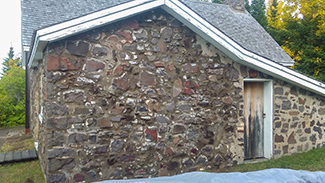
Regarding the lightkeeper’s residence, Cadeau noted the mortar had experienced extensive weathering on its windward sides.
“National Restoration performed deep repointing and stone masonry rebuilding of exterior walls. The repairs utilized local rock and local beach sand to ensure consistency with the historic materials,” he said.
Funding for the project came from DNR Recreation Passport Cultural Resource Stewardship and DNR Park Improvement/Park Endowment funds.
“We are pleased with the work that was completed,” Wild said. “With the repairs both structures should last another 150 years.”
With ongoing preservation, conservation and restoration efforts, the Copper Harbor Lighthouse buildings will continue as well-preserved examples of mid-19th-century lighthouse life on the northern frontier.
|
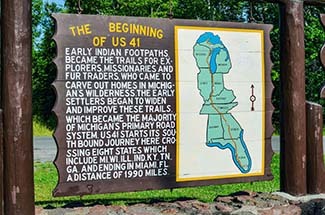
The Copper Harbor Lighthouse is part of Fort Wilkins Historic State Park and is accessible only by water. The lighthouse and keeper’s dwelling will not be open to the public this summer due to the ongoing public health emergency.
Some fun facts about Michigan lighthouses and the Copper Harbor area:
- Michigan has 126 lighthouses, the most of any inland state, and the DNR manages eight of those with partners.
- Though these lighthouses are no longer managed by the Coast Guard, it is not because the Great Lakes have gotten any safer, but because technology has improved. Lighthouses no longer need several keepers and their families to manage the lights, which have been replaced by automated lights that do not need constant maintenance.
- Copper Harbor was part of the ancestral home of the Ojibwe people for centuries until European-Americans began to arrive in the 1840s. Early white settlers came to mine the natural copper deposits. The Copper Rush of 1844 predated the more famous California Gold Rush by five years.
- Fort Wilkins Historic State Park, of which the Copper Harbor Lighthouse is a part, was originally built in 1844 to ensure order during the copper mining rush. It was abandoned a few years later but was put back into service during the Civil War and regarrisoned from 1867-1870. By the 1870s, the fort was again abandoned. In 1921 the property was designated a historic landmark, and in 1923 it became a Michigan state park. Restoration efforts took place during the 1930s and 1940s. Today, 22 buildings survive in the historic 700-acre park, which also includes two campgrounds, trails and boat launches.
- In addition to being the northernmost mainland point in Michigan, Copper Harbor also is the northern terminus of U.S. 41. The road connects Michigan to Miami, Florida, nearly 2,000 miles away.
For more information on Fort Wilkins Historic State Park and other historic Michigan parks, visit Michigan.gov/StateParks.
|
Check out previous Showcasing the DNR stories in our archive at Michigan.gov/DNRStories. To subscribe to upcoming Showcasing articles, sign up for free email delivery at Michigan.gov/DNR.
/Note to editors: Contact: John Pepin, Showcasing the DNR series editor, 906-226-1352. Accompanying photos and a text-only version of this story are available below for download. Caption information follows. Credit Michigan Department of Natural Resources, unless otherwise noted.
Text-only version
After: The south side of the original 1848 lighthouse keeper’s dwelling at Copper Harbor is shown after repairs.
Before: The west side of the original 1848 lighthouse keeper’s dwelling is pictured before repairs.
Brick: A National Restoration Inc. brick mason replaces damaged bricks with historically accurate new ones.
Harbor: A view of the Copper Harbor Lighthouse complex is shown, including, left to right, the 1933 steel tower, the 1866 lighthouse and the 1848 light-keeper’s dwelling.
Light: The Copper Harbor Lighthouse is shown from around 1910.
Repairs: A close-up view of the brick repairs to the south side of the Copper Harbor Lighthouse is shown.
Start: An interpretive sign at Copper Harbor discusses the starting point of U.S. Highway 41 in Keweenaw County.
View: A view overlooking Copper Harbor is shown. The Copper Harbor Lighthouse is visible at the end of the point at the left side of the photo.
Wilkins: Fort Wilkins Historic State Park, where history comes alive through reenactors, is also home to the Copper Harbor Lighthouse./
|